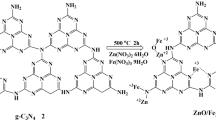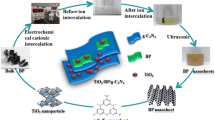Abstract
Photocatalysis-self-Fenton system, i.e., photocatalytic H2O2 generation and utilization in situ for ·OH radials production to remove organic pollutants with high-fluent degradation and mineralization performance possesses such advantages as cleanliness, efficiency and safety. However, its degradation activity always suffers from the Fe(III)/Fe(II) cycle. For this reason, graphitic carbon interface-modified g-C3N4 (CUCN) was fabricated to remarkably improve photocatalysis-self-Fenton degradation activity. The experiment results indicated that CUCN-2% photocatalyst, in which the loading percentage of graphitic carbon was 2%, demonstrated the optimum degradation performance among all the counterparts. The mineralization degree for RhB in 3 h over CUCN-2% reached 63.77%, nearly 3.35-fold higher than the pristine g-C3N4. The significantly improved mineralization efficiency was ascribed to the promoted Fe(III)/Fe(II) cycle by photogenerated electrons, which leading to the higher utilization efficiency of H2O2 through Fenton reaction, thereby producing more hydroxyl radicals. It is anticipated that our work could provide new insights for the design of photocatalysis-self-Fenton system with exceptional degradation performance for actual photocatalytic applications.
Graphical abstract

摘要
光催化自芬顿是通过光催化产生双氧水 (H2O2) 并原位利用以产生羟基自由基去除水中有机污染物, 具有降解与矿化活性高、清洁、高效和安全等诸多优点。然而, 光催化自芬顿的降解活性严重受限于Fe(III)/Fe(II)的循环。为此, 我们制备了石墨碳界面改性的g-C3N4 (CUCN), 希望通过改善Fe(III)/Fe(II)循环以显著提升光催化自芬顿降解性能。实验结果表明, 石墨碳用量为2%获得的催化剂 (CUCN-2%) 表现出最佳的光催化自芬顿降解性能。反应3h对RhB的矿化度达到63.77%, 是g-C3N4的3.35倍。显著提升的矿化性能, 来自于光生电子明显改善Fe(III)/Fe(II)循环, 造成更高的双氧水利用率, 从而产生更多的高活性羟基自由基。本研究成果可以为设计高活性降解性能的光催化自芬顿体系提供新的思路, 为获得实际光催化应用奠定理论基础。







Similar content being viewed by others
References
Li YX, Ouyang SX, Xu H, Wang X, Bi YP, Zhang YF, Ye JH. Constructing solid–gas-interfacial Fenton reaction over alkalinized-C3N4 photocatalyst to achieve apparent quantum yield of 49% at 420 nm. J Am Chem Soc. 2016;138(40):13289.
Wang CY, Zhang X, Zhang YJ, Chen JJ, Huang GX, Jiang J, Wang WK, Yu HQ. Direct generation of hydroxyl radicals over bismuth oxybromide nanobelts with tuned band structure for photocatalytic pollutant degradation under visible light irradiation. Appl Catal B Environ. 2018;237:464.
Zhou SQ, Wang Y, Zhou K, Ba DY, Ao YH, Wang PF. In-situ construction of Z-scheme g-C3N4/WO3 composite with enhanced visible-light responsive performance for nitenpyram degradation. Chin Chem Lett. 2021;32(7):2179.
Ma J, Wang K, Wang C, Chen XJ, Zhu W, Zhu GX, Yao WQ, Zhu YF. Photocatalysis-self-Fenton system with high-fluent degradation and high mineralization ability. Appl Catal B Environ. 2020;276:119150.
Jiang ZY, Wang LZ, Lei JY, Liu YD, Zhang JL. Photo-Fenton degradation of phenol by CdS/rGO/Fe2+ at natural pH with in-situ generated H2O2. Appl Catal B Environ. 2019;241:367.
Zhao S, Zhao X, Zhang H, Li J, Zhu YF. Covalent combination of polyoxometalate and graphitic carbon nitride for light-driven hydrogen peroxide production. Nano Energy. 2017;100(35):405.
Wei Z, Liu ML, Zhang ZJ, Yao WQ, Tan HW, Zhu YF. Efficient visible-light-driven selective oxygen reduction to hydrogen peroxide by oxygen-enriched graphitic carbon nitride polymers. Energy Environ Sci. 2018;11(9):2581.
Li JY, Zhang ZY, Cui W, Wang H, Cen WL, Johnson G, Jiang GM, Zhang S, Dong F. The spatially oriented charge flow and photocatalysis mechanism on internal van der Waals heterostructures enhanced g-C3N4. ACS Catal. 2018;8(9):8376.
Mu RH, Ao YH, Wu TF, Wang C, Wang PF. Synergistic effect of molybdenum nitride nanoparticles and nitrogen-doped carbon on enhanced photocatalytic hydrogen evolution performance of CdS nanorods. J Alloy Compd. 2020;812:151990.
Huang S, Ouyang T, Zheng BF, Dan M, Liu ZQ. Enhanced photoelectrocatalytic activities for CH3OH-to-HCHO conversion on Fe2O3/MoO3: Fe-O-Mo covalency dominates the intrinsic activity. Angew Chem Int Ed. 2021;60(17):9546.
Liu Q, Chen TX, Guo YR, Zhang ZG, Fang XM. Grafting Fe(III) species on carbon nanodots/Fe-doped g-C3N4 via interfacial charge transfer effect for highly improved photocatalytic performance. Appl Catal B Environ. 2017;205:173.
Liu XE, Dai LM. Carbon-based metal-free catalysts. Nat Rev Mater. 2016;1(11):1.
Fang S, Xia Y, Lv KL, Li Q, Sun J, Li M. Effect of carbon-dots modification on the structure and photocatalytic activity of g-C3N4. Appl Catal B Environ. 2016;185:225.
Dhenadhayalan N, Lin KC, Saleh TA. Recent advances in functionalized carbon dots toward the design of efficient materials for sensing and catalysis applications. Small. 2020;16(1):1905767.
Che W, Cheng WR, Yao T, Tang FM, Liu W, Su H, Huang YY, Liu QH, Liu JK, Hu FC. Fast photoelectron transfer in (Cring)–C3N4 plane heterostructural nanosheets for overall water splitting. J Am Chem Soc. 2017;139(8):3021.
Han M, Lu SY, Qi F, Zhu SJ, Sun HZ, Yang B. Carbon dots–implanted graphitic carbon nitride nanosheets for photocatalysis: simultaneously manipulating carrier transport in inter-and intralayers. Sol RRL. 2020;4(4):1900517.
Zhao S, Guo T, Li X, Xu TG, Yang B, Zhao X. Carbon nanotubes covalent combined with graphitic carbon nitride for photocatalytic hydrogen peroxide production under visible light. Appl Catal B Environ. 2018;224:725.
Zhou HY, Zhang H, He YL, Huang BK, Zhou CY, Yao G, Lai B. Critical review of reductant-enhanced peroxide activation processes: trade-off between accelerated Fe3+/Fe2+ cycle and quenching reactions. Appl Catal B Environ. 2021;286:119900.
Rincón AG, Pulgarin C. Absence of E. coli regrowth after Fe3+ and TiO2 solar photoassisted disinfection of water in CPC solar photoreactor. Catal Today. 2007;124(3–4):204.
Khamboonrueang D, Srirattanapibul S, Tang IM, Thongmee S. TiO2·rGO nanocomposite as a photo catalyst for the reduction of Cr6+. Mater Res Bull. 2018;107:236.
Hunsom M, Pruksathorn K, Damronglerd S, Vergnes H, Duverneuil P. Electrochemical treatment of heavy metals (Cu2+, Cr6+, Ni2+) from industrial effluent and modeling of copper reduction. Water Res. 2005;39(4):610.
Wang C, Wang K, He XX, Liao Y, Mao H, Zhao SL, Ma J. Constructing internal electric field in g-C3N4 significantly promotes the photocatalytic performance for H2O2 generation. Catal Lett. 2021;151(5):1225.
Xu TF, Wang DN, Dong LL, Shen HB, Lu WY, Chen WX. Graphitic carbon nitride co-modified by zinc phthalocyanine and graphene quantum dots for the efficient photocatalytic degradation of refractory contaminants. Appl Catal B Environ. 2019;244:96.
Tan LH, Xu JH, Zhang XJ, Hang ZS, Jia YQ, Wang SB. Synthesis of g-C3N4/CeO2 nanocomposites with improved catalytic activity on the thermal decomposition of ammonium perchlorate. Appl Surf Sci. 2015;356:447.
Qin PL, Zeng K, Lan ZQ, Huang XT, Liu HZ, Guo J. Enhanced dydrogen storage properties of Mg–Al alloy catalyzed with reduced graphene oxide supported with LaClO. Chin J Rare Met. 2020;44(5):499.
Wang JF, Chen J, Wang PF, Hou J, Wang C, Ao YH. Robust photocatalytic hydrogen evolution over amorphous ruthenium phosphide quantum dots modified g-C3N4 nanosheet. Appl Catal B Environ. 2018;239:578.
Zhu BC, Xia PF, Li Y, Ho WK, Yu JG. Fabrication and photocatalytic activity enhanced mechanism of direct Z-scheme g-C3N4/Ag2WO4 photocatalyst. Appl Surf Sci. 2017;391(B):175.
Huang HW, Xiao K, Tian N, Dong F, Zhang TR, Du X, Zhang YH. Template-free precursor-surface-etching route to porous, thin g-C3N4 nanosheets for enhancing photocatalytic reduction and oxidation activity. J Mater Chem A. 2017;5(33):17452.
Zhang Y, Zhao SM, Su QW, Xu JL. Visible light response ZnO–C3N4 thin film photocatalyst. Rare Met. 2021;40(1):96.
Yang Y, Zhang C, Huang DL, Zeng GM, Huang JH, Lai C, Zhou CY, Wang WJ, Guo H, Xue WJ. Boron nitride quantum dots decorated ultrathin porous g-C3N4: intensified exciton dissociation and charge transfer for promoting visible-light-driven molecular oxygen activation. Appl Catal B Environ. 2019;245:87.
Li X, Xie J, Jiang CJ, Yu JG, Zhang PY. Review on design and evaluation of environmental photocatalysts. Front Env Sci Eng. 2018;12(5):1.
Zhang JZ, Lang JY, Wei Y, Zheng Q, Liu LY, Hu YH, Zhou BX, Yuan CL, Long MC. Efficient photocatalytic H2O2 production from oxygen and pure water over graphitic carbon nitride decorated by oxidative red phosphorus. Appl Catal B Environ. 2021;298:120522.
Chen X, Zhang WW, Zhang LX, Feng LP, Zhang CX, Jiang J, Yan TJ, Wang H. Sacrificial agent-free photocatalytic H2O2 evolution via two-electron oxygen reduction using a ternary α-Fe2O3/CQD@ g-C3N4 photocatalyst with broad-spectrum response. J Mater Chem A. 2020;8(36):18816.
Yang LP, Dong GH, Jacobs DL, Wang YH, Zang L, Wang CY. Two-channel photocatalytic production of H2O2 over g-C3N4 nanosheets modified with perylene imides. J Catal. 2017;352:274.
Che HN, Gao X, Chen J, Hou J, Ao YH, Wang PF. Iodide-induced fragmentation of polymerized hydrophilic carbon nitride for high performance quasi-homogeneous photocatalytic H2O2 production. Angew Chem Int Ed. 2021;60(48):2.
He Z, Sun C, Yang SG, Ding YC, He H, Wang ZL. Photocatalytic degradation of rhodamine B by Bi2WO6 with electron accepting agent under microwave irradiation: mechanism and pathway. J Hazard Mater. 2009;162(2–3):1477.
Liang LP, Cheng LB, Zhang YT, Wang Q, Wu Q, Xue YY, Meng X. Efficiency and mechanisms of Rhodamine B degradation in Fenton-like systems based on zero-valent iron. Rsc Adv. 2020;10(48):28509.
Gu JY, Luo CH, Zhou WF, Tong ZP, Zhang HF, Zhang PH, Ren XD. Degradation of Rhodamine B in aqueous solution by laser cavitation. Ultrason Sonochem. 2020;68:105181.
Shiraishi Y, Kanazawa S, Sugano Y, Tsukamoto D, Sakamoto H, Ichikawa S, Hirai T. Highly selective production of hydrogen peroxide on graphitic carbon nitride (g-C3N4) photocatalyst activated by visible light. Acs Catal. 2014;4(3):774.
Samanta S, Yadav R, Kumar A, Sinha AK, Srivastava R. Surface modified C, O co-doped polymeric g-C3N4 as an efficient photocatalyst for visible light assisted CO2 reduction and H2O2 production. Appl Catal B Environ. 2019;259:118054.
Yu FY, Wang K, Wang C, He XX, Liao Y, Zhao SL, Mao H, Li XT, Ma J. Anthraquinone covalently modified carbon nanotubes for efficient and steady electrocatalytic H2O2 generation. Chem Res Chin U. 2020;36(6):1332.
He XX, Shang HY, Wang C, Chen L, Gong ZH, Wang J, Zhao SL, Ma J. Significantly influenced photocatalytic performance for H2O2 generation over ultrathin g-C3N4 through regulating the migration orientation of photogenerated charge carriers. Chin Chem Lett. 2021;32(11):3377.
Acknowledgements
This work was partly financially supported by National Natural Science Foundation of China (No. 21906132), Department of Science and Technology of Sichuan Province (Nos. 2020YFG0158 and 2020YFH0162) and Sichuan Provincial Engineering Laboratory of Livestock Manure Treatment and Recycling (Sichuan Normal University) (No. 202104).
Author information
Authors and Affiliations
Corresponding authors
Ethics declarations
Conflict of interests
The authors declare that they have no conflict of interest.
Supplementary Information
Below is the link to the electronic supplementary material.
Rights and permissions
About this article
Cite this article
Chen, L., He, XX., Gong, ZH. et al. Significantly improved photocatalysis-self-Fenton degradation performance over g-C3N4 via promoting Fe(III)/Fe(II) cycle. Rare Met. 41, 2429–2438 (2022). https://doi.org/10.1007/s12598-022-01963-w
Received:
Revised:
Accepted:
Published:
Issue Date:
DOI: https://doi.org/10.1007/s12598-022-01963-w




